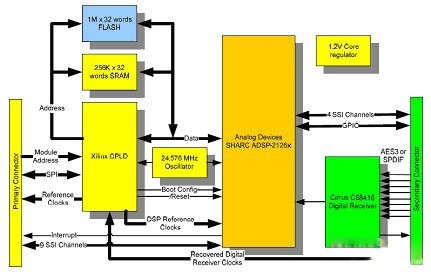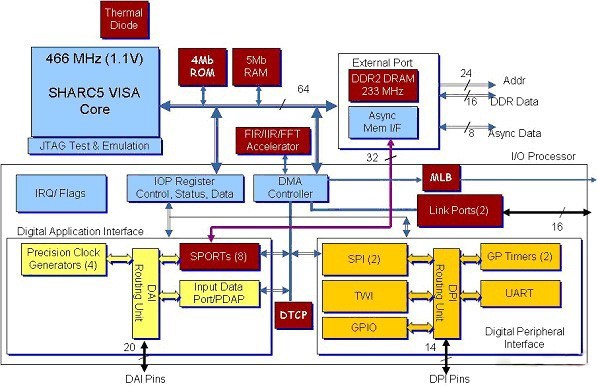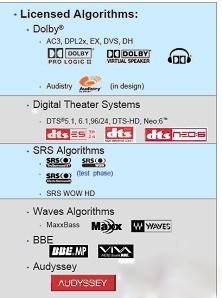Traditional audio equipment is the world of analog technology. However, this situation is changing rapidly in recent years, with more and more professional audio systems, car audio, and consumer audio equipment using digital features due to their unique performance advantages, higher cost performance, and simplified design tool support. Signal processor technology.
Engineers who are concerned about professional audio products may notice a phenomenon: Floating-point DSP stands for the SHARC processor, which is favored by more and more engineers and enterprises. It has been well-known in the industry for only one year from 2008 to 2009. Enterprises choose SHARC processors in their audio products - PreSonus' StudioLive digital audio mixer and multi-channel recording system, Damage Control's electric guitar, FUJITSU TEN's car audio system... increase.
In fact, if it is not a space limit, this list can be very long and long, why is the SHARC processor favored? The industry's explanation is because the SHARC processor is becoming the "fact standard" for mid- to high-end audio applications. This article will select several application cases to analyze the design considerations behind the selection of SHARC processors from an application design perspective.
Top audio system design case analysis
1. Excellent car audio system selection SHARC
In the Audi A5 Coupé's in-car entertainment system, designers also selected Analog Devices' Blackfin and SHARC processors to redefine the luxury in-car entertainment experience with a variety of signal processing technologies. The ADSP-21362 processor was selected as the basis for B&O Surround Stereo amplifiers with its high performance, rich audio feature set and good reputation in the audio market. The SHARC processor performs an optimized audio filtering algorithm that adaptively echoes the car's body to maximize sound quality.
Fujitsu Ten, which is known for designing and producing high-quality audio equipment, also chose the floating-point SHARC processor ADSP-21364 as a digital signal processing engine to enhance the performance of its audio amplifiers. For high-performance audio, advanced sound equalization and superior sound quality in audio equipment in the cab environment, Fujitsu Ten has a soft spot for floating-point SHARC processors in many options. The following is a brief description of the design of the SHARC processor used by Fujitsu Ten.
The outstanding core performance, flexible connectivity options, and integrated audio-specific peripherals of the SHARC processor enable Fujitsu Ten to overcome the challenging constraints of the car's cab and deliver an unparalleled car audio experience from traditional OEM car amplifiers. . Utilizing the high-performance SHARC DSP architecture to achieve its leading "sound space control technology", Fujitsu Ten's power audio amplifiers have established an industry leading position with advanced sound balance and sound processing power for perfect sound quality.
The SHARC processor enables Fujitsu Ten to reduce the sound reflections in the cab through real-time signal processing and offset each other, thereby compensating for various sound reflection effects and improving overall sound quality. In addition, the SHARC processor enables Fujitsu Ten to compensate for the speaker's sound constraints, including speaker frequency response and cab speaker installation challenges, enhancing surround sound in all spatial locations in the cab. With these advanced features, Fujitsu Ten's SHARC processor-based power audio amplifiers provide automotive manufacturers with a flexible, high-quality audio amplifier platform that can be seamlessly integrated into virtually any vehicle to provide users with their Expect a rich listening experience.
ADI's floating-point SHARC processor is recognized as the gold standard for high-quality audio processing. The processor's high-performance digital signal processing (333 MHz /2 GFLOPS) enables Fujitsu Ten's voice space control technology to produce clarity and sound effects comparable to high-quality home audio equipment. The SHARC processor also enables Fujitsu Ten to implement the finite impulse response (FIR) filter required for dynamic sound adjustment.
In addition to the intensive computing power required by the Fujitsu Ten audio power amplifier, the SHARC processor simplifies product development and time-to-market by integrating large memory arrays and advanced on-chip peripherals into a single, converged architecture. The ADSP-21364 processor's integrated 8-channel asynchronous sample rate converter is a key component of Fujitsu Ten's voice space control technology, which helps Fujitsu Ten reduce BOM costs and reduce the size of audio amplifiers. The on-board sample rate converter not only achieves high-intensity audio signal conversion, but also reduces the performance delay typically caused by external peripherals.
2, SHARC helps PreSonus achieve low-cost professional audio system
PreSonus is one of the world's most innovative suppliers of audio production equipment. PreSonus' StudioLive digital audio mixer and multi-channel recording system selects Analog Devices' 32-bit floating-point SHARC processor to deliver professional-quality digital processing performance and sound quality in a small, cost-effective system. StudioLive is known as "the world's most powerful and flexible sixteen channel digital mixer" with sixteen high headroom XMAX mic preamps, built-in 32x18 FireWire recording and playback engine, and 4 bands EQ's “Fat-Channel†processing, compressors, limiters and gates, DSP effects, six auxiliary buses, four subgroups, extensive LED measurements, mixer save and cancel, channel amplifier group save/cancel/copy / Paste and intercom system, etc., broke through the new boundaries of music performance and production.
PreSonus wanted to design a digital audio mixer with unique features to support live performance and studio production. The new system requires a small form factor, is easy to move, and has a low BOM cost to appeal to customers with limited budgets without sacrificing performance, functionality and sound quality. ADI's ADSP-21369 processor brings PreSonus a perfect combination of price/performance and advanced features, freeing up all the power of the StudioLive system and ultimately producing sound quality beyond what PreSonus engineers expect.
StudioLive combines a professional digital mixer with a complete multi-channel recording system to provide the most creative environment for users who demand both “live play†and optimal studio production. To achieve this unique combination of features, PreSonus needed a processing platform that would support full mixing, dynamic effects processing and equalization while providing the performance required for real-time music processing and recording. The original StudioLive product design used a field-programmable gate array (FPGA) as the main processing engine, but PreSonus engineers quickly discovered that FPGA solutions produced unacceptable delays while increasing the difficulty of complex sound effects. . With the floating-point SHARC architecture, PreSonus has superior computing power to ensure outstanding performance, as well as a robust instruction set for more flexible programming and customization of PreSonus audio algorithms. In addition to SHARC, PreSonus also considered the use of competing digital signal processors in StudioLive, but due to the floating point performance advantages of 400 MHz / 2.4 GLOPS, plus 2 Mb on-chip SRAM, 6Mb on-chip ROM and support for SDRAM, SRAM, flash memory With the 32-bit external memory interface of the ROM memory, they finally chose SHARC. The exceptional core and memory performance combined with outstanding I/O throughput allows SHARC to exceed StudioLive's computationally intensive real-time signal processing requirements, ensuring the best distortion-free audio performance with near-infinite headroom margin.
PreSonus engineers leveraged SHARC's powerful processor architecture, which enables PreSonus to streamline the development process and meet its high-profile design goals. Various on-chip audio-specific and general-purpose peripherals such as pure digital S/PDIF transmitter/receiver, 8-channel asynchronous sample rate converter, 8 high-speed serial ports, 4 precision clock generators, and multiple serial interfaces The ADSP-21369 simplifies the hardware design of the StudioLive and minimizes BOM costs.
SHARC is the ideal platform for audio technology development engineers to incorporate unique features into their products with a high degree of flexibility. For example, PreSonus has developed a task scheduling kernel that uses SHARC's Direct Memory Access (DMA) to mix and process live audio streams with very low latency. This core can be used to manage the dynamic allocation of resources and memory and minimize overhead through eight frame sampling cycles, ensuring precision audio processing and fidelity for demanding live audio applications.
With SHARC, PreSonus enables you to achieve sound quality levels that are more than twenty times higher than StudioLive, as well as the flexibility to quickly add custom digital audio effects, including indoor sound field simulation, reverb, delay, and time-based effects. StudioLive comes with all the components needed for live sound production, including 28 compressors, 28 limiters, 28 gates, 28 high-pass filters and 2 master stereo limiters for musicians and audio engineers The cost of the external effect processing module is saved, and the time for equipment installation/disassembly during live performance is saved.
3. SHARC-based professional audio application module
Lab X Technologies works with OEMs to develop audio and interconnect products for customers, including user interfaces, preamplifiers, studio mixing consoles, home theater, sound distribution, and broadcast solutions. Lab X developed the MakoTM 2126x DSP module based on the SHARC ADSP-21262. OEMs can integrate Mako boards in their designs, or integrate them with Lab X for customers or provide complete solutions. Mako is specifically designed for integration into home theater, professional audio, and commercial audio applications.
Increasing audio applications require a lot of signal processing power, and thanks to the integrated SHARC processor, Mako not only saves OEM time, but also reduces development costs. SHARC is a 32-bit/40-bit floating-point processor optimized for high-precision signal processing applications such as audio applications that require high-performance processors to run arithmetic-intensive decoders and post-processing algorithms. The SHARC ADSP21262 has a 5 ns instruction cycle time at 200 MHz. With single instruction multiple data (SIMD) computing hardware, the SHARC ASDP21262 achieves 1200 MFLOPS performance at 200 MHz. Mako also uses the SHARC ADSP-21266 processor to provide PCM, Dolby Digital, DTS, Dolby DPL2 and THX post-processing algorithms for home theater decoders.
With six full-duplex serial ports, SHARC provides low-cost interfaces to a variety of digital and mixed-signal peripherals, such as Analog Devices' audio codecs, digital-to-analog converters, or analog-to-digital converters. The processor includes a Serial Peripheral Interface (SPI) that provides SPI-compatible port communication with other SPI-compatible ports. A digital audio interface is also provided to allow various peripherals to be connected to any of the processor's 20 DAI pins. One. The SHARC processor contains up to 13 simultaneous serial ports for I2S or Time Division Multiple Access (TDM) inputs and outputs to interface the ADC to the audio processor.

Figure 1: Functional block diagram of the Mako 2126x DSP module
Why is SHARC?
Some of the performance characteristics of the SHARC processor have been introduced above, and the main features of the processor are summarized below. The SHARC processor supports high-performance 32-bit and 40-bit extended floating-point operations as well as 32-bit fixed-point operations. The core uses a single instruction multiple data (SIMD) architecture that contains two arithmetic units capable of executing code in parallel. This means that the user can execute the same instruction in the same cycle in the two operating units. The fastest SHARC processor has a core clock frequency of up to 400MHz and a performance of 2.4Gflop. In order to maintain this single-cycle operational performance, there is a high bandwidth between the core and the memory. SHARC also has some advantages of floating-point operations, such as reducing quantization errors, achieving higher precision and greater dynamic range. These features make SHARC ideal for mixers, amplifiers and synthesizers, automotive audio amplifiers, and more, from home theater systems and HD DVDs to professional audio systems.
For general applications, some of the unique advantages of SHARC can be attributed to 32-bit floating-point operations, which clearly provides significant advantages for design. In addition, the SHARC processor not only has a large capacity of on-chip memory, but also provides a glueless interface to the external memory. For some more specialized applications, such as consumer and automotive applications, some SHARC devices also have an audio decoder built into the ROM, and a sample rate converter and S/PDIF interface are also integrated in the hardware. For some special automotive customers, ADI has added a hardware DTCP encryption engine to the SHARC processor.

Figure 2: Functional Block Diagram of the SHARC ADSP2146X, an advanced representative of general purpose DSPs.
SHARC processors are favored by so many professional audio equipment vendors. In addition to the optimized architecture and high performance mentioned above, powerful development tools are an important reason. The graphical audio design tool VisualAudio® includes a large number of SHARC processor audio expertise and a large library of optimized SHARC audio processing modules, enabling even experienced engineers to take advantage of a basic set of audio libraries and tools. Start up its projects and modularize the development process to reduce learning time. VisualDSP++ is another software development and debugging integration environment provided by ADI for its series of DSP products. The SHARC dedicated compiler integrated in VisualDSP++ can fully utilize the advantages of SHARC SIMD architecture, and supports single-cycle execution of floating-point operations in VisualDSP++. The emulator supports application development without hardware. VisualDSP++ also includes a VDK or real-time operating system kernel and scheduler. The hardware tool EZ-KIT Lites provides a good evaluation platform for programming and developing software running on SHARC.

Figure 3: Licensed algorithms available with the ADI SHARC processor.
For example, all developers of the Audi A5 project design team use ADI's VisualDSP++ integrated development and debugging environment, which allows efficient management of the project from start to finish with a single interface. Developers also received online and on-site technical support from Analog Devices, leveraging the experience and background of ADI engineers in solving complex hardware and cabling. Using ADI's cost-effective EZ-KIT Lite® evaluation kit, Fujitsu Ten quickly performed a performance evaluation of the SHARC processor. The evaluation kit is connected to the host PC via a USB interface, allowing developers to familiarize themselves with the features and functions of SHARC and efficiently prototype a variety of applications. The VisualDSP++ software development and debugging environment is easy to install and use, which further simplifies the product development process and shortens the time-to-market of its power audio amplifiers. PreSonus engineers used the integrated software development environment VisualDSP++ when developing StudioLive. Together with the EZ-KIT Lite evaluation board, VisualDSP++ helps PreSonus development engineers streamline the product development process and reduce time to market.
Users can use the EZ-KIT Lite evaluation board and the VisualDSP++ integrated development environment to evaluate the architecture through the PC host's toolset. In particular, VisualDSP++ allows programmers to develop and debug applications flexibly and easily in a visual environment. With the support of VisualDSP++ development tool functions and C/C++ compiler, engineers can easily optimize the source code. If necessary, you can debug assembly-level code directly, and use high-level language (C language) to write non-performance-critical code. ADI also provides a VisualAudio graphical design programming environment for the application of SHARC processors in professional audio processing. It includes a toolkit and a software database based on VisualDSP++. VisualAudio provides a variety of software building blocks for audio design systems, including volume control, tone control, delay, compression effects, etc. It also supports audio modules written by customers. VisualAudio provides an intuitive drag-and-drop graphical user interface that can be used immediately on a ready-to-use reference hardware platform, such as the SHARC EZ-KIT Lite evaluation board. In addition, some of ADI's SHARC processors integrate high-fidelity audio decoders (such as high-fidelity audio decoders used in home theater systems) to make it easy for customers to build high-quality audio receiver platforms.
In addition, the SHARC processor takes into account many of the user's application environments: for high-temperature environments, the SHARC processor extends the ambient temperature to 105 degrees Celsius, which is suitable for demanding applications such as automotive applications; SHARC has always maintained a major advantage -- Compatibility, from the first generation of SHARC products to the current fourth-generation SHARC products, the devices are pre-pin compatible, meeting the multiple selection needs of users and product replacement requirements, when upgrading or developing a new generation of products. Users do not need to redesign the board, they can be directly replaced with new SHARC devices with more functions. In addition, the same series of SHARC devices also have code-compatible features to facilitate software migration of the solution.
This type of Cable Tray is made through domestic and abroad experience and is improved from the making experience of similar products in our factory.It has many advantages,light weight,low cost,unique type,easy installation,good heat dissipation and ventilation.This type generally applies to large diameter cables laying, especially suitable for high and low voltage power cable laying.
Protectors for fiberglass Ladder Type Cable Tray are prepared.You can mark your needs when you give orders or simply purchase according to the size of protector.All accessories can be used in cable tray and ladder type cable tray.
Three types of treatment to surface,electrostatic spray,galvanization,painting.In high corrosive circumstances,special anti-corrosive process is available.

Ladder Type Fiberglass Cable Tray
Heavy Duty Cable Tray,Fiberglass Ladder Cable Tray,Heavy Duty Fiberglass Cable Tray,Ladder Type Fiberglass Cable Tray
Jiangsu Loncin Electric Equipment Co.,Ltd , https://www.loncincabletray.com